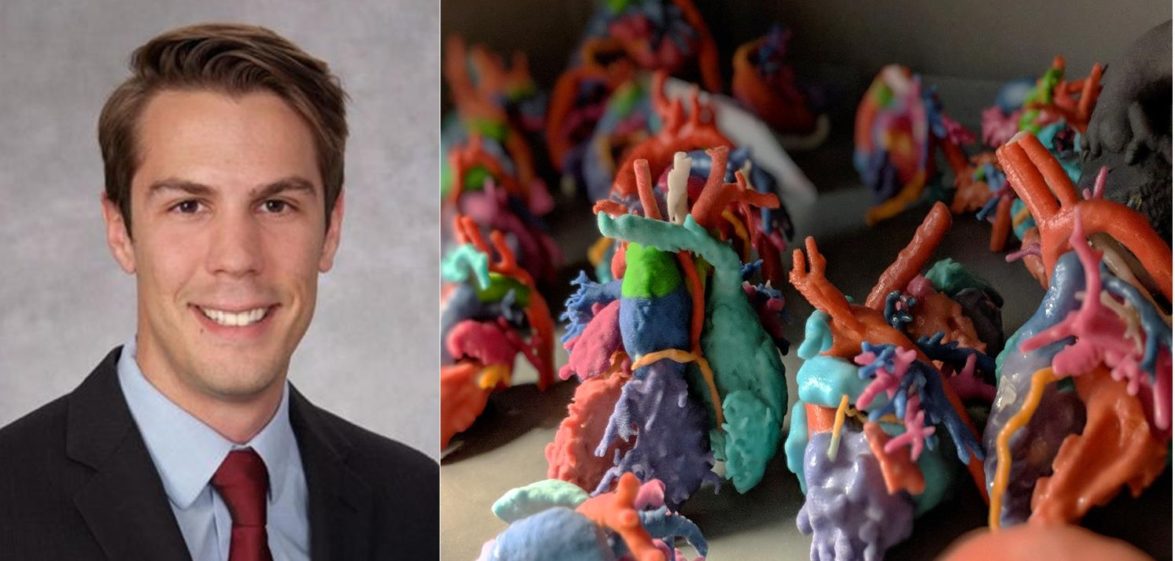Justin Ryan, Ph.D., is an artist — a very specialized, highly technical, life-improving artist. After all, as director of the new 3D Innovations (3DI) Lab at Rady Children’s Hospital-San Diego, he and his team craft 3D models of hearts, brains, bones and more to streamline surgical plans and improve outcomes for even the Hospital’s most complex cases. Find out more about his fascinating role, his unique professional background and his peaceful spirit animal in our latest edition of “Getting to Know.”
Describe a typical workday.
The exciting part about working in a translational research lab — one that uses established scientific findings to enhance technologies, tools and processes and improve pressing medical issues — is that there is no typical workday. Some days I may start the day developing a 3D model from a CT scan or an MRI to later be delivered to one of our surgeons. Another day, I may be focused on developing a device prototype with our clinicians or allied health professionals, or presenting to patient families or community members about the exciting activities coming from the 3DI Lab.
A background in computer imaging and animation is unique for your field, but also makes so much sense. How did you arrive in your current profession, and how do you feel your artistic expertise helps you succeed?
I had the pleasure of attending Arizona State University, where I was mentored by professor and artist Dan Collins, Ph.D. in the field of intermedia (a style of art whereby collaboration between different disciplines of art is encouraged). My colleagues and I forged new art-based methods of creating anatomical models with the intent of enabling and informing engineering projects. Professor David Frakes, Ph.D., my biomedical engineering mentor, enabled a pathway for me to continue my scientific (and artistic) pursuits for the purpose of advancing medical research. It is incredible that the same process, hardware and software that enabled me to be an intermedia artist also enabled me to create models that helped and augmented clinical and surgical care processes.
With the new 3DI Lab, what has been your proudest accomplishment thus far? What milestones do you and your colleagues hope to hit a year, five years, a decade from now?
I haven’t been at Rady Children’s for too long, but I am thrilled at the progress we have made as a team in building the 3DI Lab. Our invested team members have already made more than 25 models for surgical care support in a matter of months. We have also partnered with industry colleagues in helping to test and improve on future 3D printers. We work closely with medical societies in enabling others to do 3D printing safely and effectively. In the future, I think some key objectives will be enabling 3D printing to be used hospital-wide for improved patient care and promoting a landscape of innovation (to enable our team to create and make medical solutions). I’m excited by the team that has come together to support this initiative — it is truly a collaborative effort!
What makes the 3DI Lab stand out from other similar efforts?
Many other 3D printing initiatives are driven by passionate clinicians in a single department. The result of this format is fantastic work that applies to that department’s patients. In joining Rady Children’s, I can say I am thrilled at the welcome I received from so many departments that are interested and engaged in finding new avenues to explore this technology. The 3DI Lab is an innovating landscape that is open to the entire Hospital. We are also proud to be the first lab of its kind in Southern California in that we are exclusively focused on building models for pediatric patients.
What do you think is most exciting about your job?
I recognize I am in a unique position as a biomedical engineer. Most biomedical engineers work on a product line or research for many years before seeing the result of their work. I am fortunate to see the effect our 3D models and prints have on my clinical and surgical colleagues, and sometimes even on our patient families. In fact, we are developing specific applications for our families so that they, too, may be directly impacted by emerging 3D technologies. One aspect of that will be an interactive education web portal — the site will contain 3D models and new informational content to our families with children with congenital diseases.
When you’re not at work, what are you up to?
Since I have moved to San Diego, I have taken up surfing. I am still very much a beginner, but I absolutely love it! When I get enough time to myself, my wife and I head to Tourmaline to surf and enjoy the beach. Exploring San Diego and the surrounding areas is certainly an interest of ours.
If you were an animal, which would you be and why?
I love that bonobos (a close relative to the chimpanzees) work to solve most of their societal ills through non-violent means.
If you were only able to listen to five bands or artists ever again, which would you pick?
The Kills — absolutely love seeing them live; the Beatles; the Ramones; The Black Keys; and The Lumineers.
You have unlimited funds to take your dream vacation. Where are you headed?
Well, it may not be an unlimited funds situation… but my wife and I will be heading to our dream vacation (actually our delayed honeymoon!) to New Zealand this summer. We are particularly excited to hike and kayak around the beautiful landscape. Specifically, we hope our kayaking trip in the Milford or Doubtful Sound will cross paths with the native penguins.
